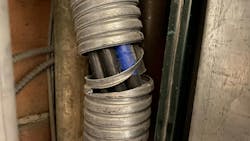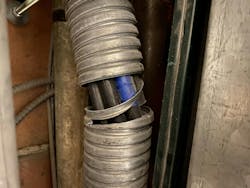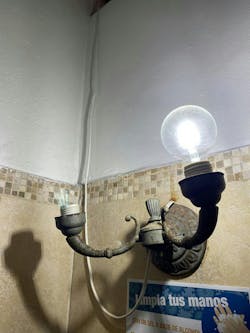Illustrated Catastrophes: So Many Questions Need Answers
All references are based on the 2023 edition of the NEC.
So Many Questions Need Answers
I’m not sure what caused the flexible metal conduit (FMC) to break open the way it did in this installation, but it leaves me questioning the integrity of the required bonding and grounding paths specified in Sec. 250.4(A)(1)-(5). Is there still an effective ground-fault current path? Does this broken metal raceway still provide the electrical continuity specified in Sec. 300.10?
This broken FMC also has me questioning the integrity of the conductor insulation. Has it been compromised because of a nick, gouge, or slice in the insulation? Was this damage intentional? Was this a mistake and abandoned in place? One conductor appears to be completely cut off. Is it energized? I did not have a voltage meter with me when I spotted this installation, and I could not verify whether it was energized or not.
Section 348.12(7) does not permit installing FMC where it is exposed to physical damage. It sure looks like this FMC has suffered some physical damage. Section 348.2 prohibits FMC from being reconditioned, so there is no fixing this FMC. It will need to be removed. Section 110.12(B) prohibits broken or damaged parts that adversely affect the safe operation or mechanical strength of equipment. Many answers are certainly needed here.
Crazy Cord Connection
I saw this arrangement right above a sink in the men’s bathroom of a restaurant. The power for that metal luminaire is being fed from a 2-wire flexible cord. There is no equipment grounding conductor connected to this fixture as required by Sec. 410.42. The flexible cord also appears to be pinched between the fixture canopy and the wall.
Section 400.17 requires flexible cords and flexible cables to be protected by a fitting or bushing where passing through holes in covers, boxes, or other enclosures. A damaged cord could result in the entire metal fixture becoming energized, creating a severe shock hazard. As specified in Sec. 400.12(1), flexible cords, flexible cables, power supply cords, and cord sets are not permitted to be used as a substitute for the fixed wiring of a structure. Section 400.12(2) prohibits running flexible cords, flexible cables, power supply cords, and cord sets through holes in walls, floors, or ceilings. There is no outlet box installed for this fixture and its conductor splices. When using cable wiring methods, Sec. 300.15 requires a box or other enclosure to be installed at each outlet point — and where conductors are spliced or terminated.
About the Author

Russ LeBlanc
Owner
Russ started in the electrical trade as an apprentice in 1985. He worked his way up to become a Journeyman Electrician and then eventually became a Master Electrician and Licensed Construction Supervisor. In 1999 Russ become an Electrical Instructor for The Peterson School of Engineering in Massachusetts where he developed his passion for teaching, and quickly became Department Head of Electrical Instruction. Russ has taught thousands of apprentices, electricians, engineers, inspectors, and other electrical professionals during his career as an instructor. He continues to provide electrical professionals with Electrical Code seminars, Arc-Flash Awareness training seminars and educational material through his LeBlanc Consulting Services in North Reading, MA whose specialty is educating electricians. He has been an active member of the NFPA Electrical Section and has authored hundreds of National Electrical Code proposals and comments which have become Code rules to improve the safety for the electrical industry. Russ is also an IAEI certified Electrical Inspector.
Please visit www.russleblanc.net for more information.


